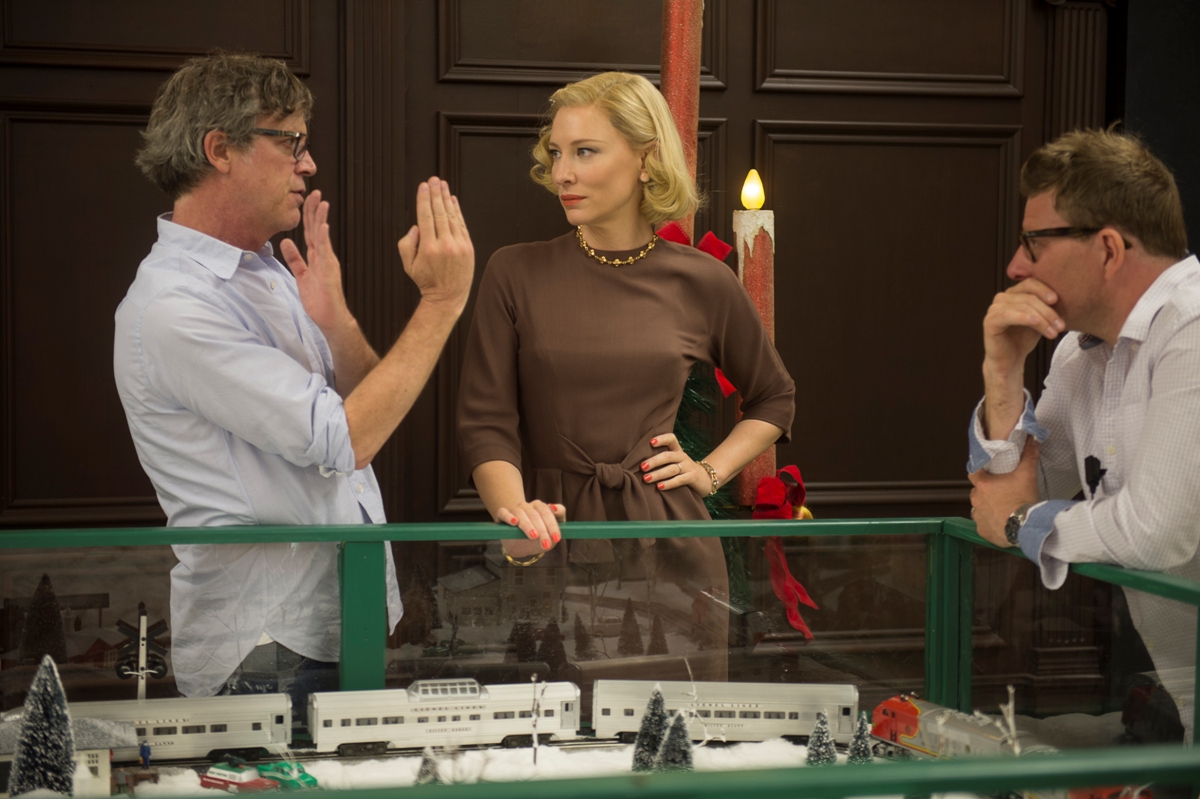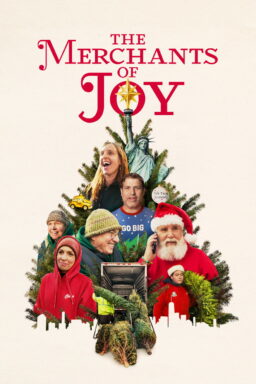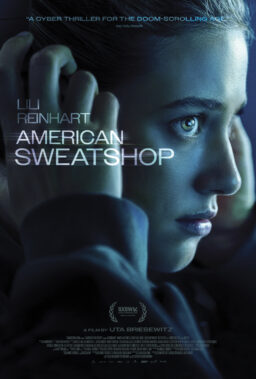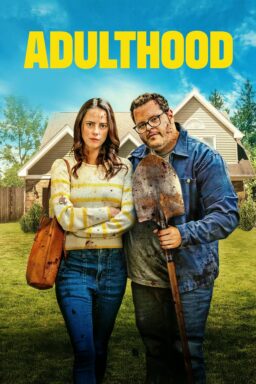The latest film from American director Todd Haynes is highly potent with a poetic action found throughout his projects, from 1991’s “Poison” to his 2002 Douglas Sirk-inspired melodrama “Far from Heaven“—the stolen gaze. In “Carol,” two women in the 1950s are brought together by this very type of cosmic meeting of the eyes; after seeing each other at a department store, clerk Theresa (Rooney Mara) unexpectedly enters into a relationship with upper-class wife and mother Carol (Cate Blanchett). Delicately, they explore the high of their mutual but taboo attraction, with Mara’s big eyes expressing a curiousness against Blanchett’s more confident grin. Meanwhile, the women’s relationship dramatically alarms Carol’s insecure husband Harge (Kyle Chandler), who threatens to take his children away from their mother if she doesn’t cease the relationship with Therese.
With his first feature since 2007’s “I'm Not There,” Haynes’ intellectual grasp on human connection and the female experience proves yet again to be invaluable, working here from a script by Phyllis Nagy that adapts the Patricia Highsmith novel “The Price of Salt.” “Carol” is also enlivened by a sumptuous eye from cinematographer Ed Lachman, and features a thoroughly romantic score from Carter Burwell.
While Haynes was in town to present “Carol” at last month’s Chicago International Film Festival, RogerEbert.com sat down with him to talk about the film, the gripping simplicity within one of its best scenes, how the similarly-themed drama “Far From Heaven” is a different beast in comparison, and much more.
Along with your other films, there’s an energy in “Carol” between characters that comes from them stealing gazes from each other. What is your interest in the potent feeling of gazing? Where do you think that comes from?
It’s sort of about what we’re doing as viewers watching a movie. That looking is … we’re supposed to be invisible watching movies in the dark, anonymous, [the] camera is hidden, all of the apparatus is hidden. And we’re pretending that this thing is just happening by itself. But in fact, all of the machinery of looking is informing what we’re looking at. And so when stories and characters are looking at each other, or at things, or as in “Carol”—when the things being looked at are seen through windows and window panes and glass that’s dirty—the act of looking, and even the act of a camera looking is suggestive in that. I like things like that. I like making you think about … the thing that we’re not really supposed to think about, and yet all of our power comes from the act of looking, and what we project onto what we see.
It’s the one way we can express ourselves if we have to, if we can’t have essentially whatever that is, the least we can do is look.
Or even more than that, people forget that … when people ask me, “What about the chemistry between Cate and Rooney, and how did you do that?” I always think … my hunch is that, “Yes, they are beautiful, yes they work well together as actors, yes they prepare to consider all of the elements of the story.” But in a way if you set up certain conditions for the viewer, chemistry is what you bring to it. The feeling is what you bring to it. What’s alive is you, not it. It’s just a projection on the wall. We make it alive.
In that regard, aside from your own storytelling experience, where do you think your intellect about human connection comes from? What art or experience informs that?
Well, movies. Probably more than anything else. I’ve always been interested in visual art, and used to be much more into theater when I was younger, or more knowledgeable about what’s going on. And literature has played a big part in my life. But I think there’s nothing that’s had a sort of weirdly formative impact on me more than movies. My very first movie, “Mary Poppins,” which I talk about, it just turned me into an obsessive, creative creature who had to sort of reply to the experience by drawing things, making things. It was like it forced, it made me into this obsessive, creative creature … I don’t know any other way of putting it. And in some deeply primal way—I’m sure there’s something about that maternal figure and maybe there’s all these kinds of Freudian roots to that, that I’ll lead to somebody else to extrapolate like you—but I think it was the power of the experience of watching a movie that just riveted me.
What do you think is the most romantic movie you’ve ever seen?
Well, the next movie that I became outrageously obsessed with as a kid, because my childhood was sort of marked by little islands of obsession that I kind of leapt from one to the next, was “Romeo & Juliet,” which was the Franco Zeffirelli version in 1968. That year I was seven, and I remember it was also the year of “Oliver!” And that year, there was a rite of passage, where everybody’s birthday party was going to see “Oliver!” So I kept seeing “Oliver!” over and over again at everybody’s birthday party, because you just did it—I grew up in LA. But then, some of us got to see “Romeo & Juliet,” where Olivia Hussey’s bosom was revealed and Leonard Whiting’s butt was revealed, and it was like, “Whoa, this is so intense and sexual, and erotic!” And it related, of course, fairly subconsciously at the time, to the youth culture, the hippie culture of the ‘60s. But in the most romantic way. The music was so gorgeous. So I became ob-sessed with “Romeo & Juliet.” All of the sudden the friends of mine who had seen “Romeo & Juliet” were in a different place than those who had only seen “Oliver!” That did it. But that was an intensely romantic film that was a formative film for me.
There is a spectacular scene early in “Carol” in which Cate and Rooney are simply having lunch, but it is rich with the type of power dynamics that make this film resonate so deeply. Along with how it’s shot and cut, the performances seem to be very fine-tuned. When it comes to your performers and the body language they’re expressing, how precise do you like to be?
To me, it’s stuff that is scripted, it’s already determined. There are very few things we came up with in the moment that I actually remember at all. I think it’s more just little things like Rooney repositioning herself on the seat, and a weird little sound the cushion made under her that was almost like a burp. But just the fact that we know Cate is smoking, offering Rooney a cigarette, the precociousness of her trying to act like she does this all of the time, that she drinks martinis all of the time, just very simple, universal or familiar kinds of content that these actors were able to bring such exquisite nuance to and consideration to. And, I do think it’s shot very simply, and it’s cut very simply. I’m very proud of the editing that [editor Affonso Gonçalves] and I allowed in that scene. Because if you try to show every moment, then the rhythm of cuts starts to accelerate, and then the tensions go away. You’re ahead of the tensions, and you’re not able to actually live in them and actually squirm a little bit within them. And that’s what Therese is doing in that scene. Delightedly, but also excruciatingly, and that’s that great combination of feeling that defines that kind of love.

And visually, you’re working with a distinct amount of negative space. Carol’s gaze has a great amount of power with an over-the-shoulder shot while Therese seems so small in the frame.
Yeah, it’s just extremely simple and you have these extraordinary performers, and just the right amount of talking, and not too much. And holding on a change of topic, where you stay on the actor, as they change from one topic to the next, is just like a [cringing sound], [a] discomfiting thing to do, but it makes you feel what that’s like, and I think it’s more memorable that way.
Was that something you knew you would do when going into the film, that you’d handle it with a lot of simplicity?
Yes, it definitely always felt that way to me. But very quickly, Affonso and I sort of found that rhythm in the editing room. And you kind of need to, that’s the kind of thing, if you establish a different kind of rhythm, it’s very hard to pull back from it. You have to be very mindful of when you deviate rhythmically and why. And of course, there’s scenes where that is true, where what happens in the action calls for it, but you want to be able to let those scenes work, and audiences would just start to jump out of their skin if they weren’t prepared for that rhythm. And maybe some of them still do.
Did you have a lot of time to rehearse with Cate and Rooney?
We had two weeks, which is actually somewhat luxurious for prep. Not typical for low budget movies. And we just had some time with the actors, and it was so great, and not just Cate and Rooney, but the principals. And it’s just really time to read through stuff, to talk about the characters, the situations, the backstory. Especially with Kyle and Cate, that was extremely important.
Is it more challenging to tell a story that’s closer to realism like “Carol,” or was the established style within “Far from Heaven” more challenging?
I think the style of “Far from Heaven” is more challenging, ultimately. I think we’re less accustomed to it. I noticed that there were all these kinds of practices in a working set that had to be un-practiced on “Far from Heaven,” which was so interesting. Our set person, our props person, after the party wanted to have cigarette butts in the ashtrays and half-finished drinks, and I said, “No. It should look completely clean.” [Laughs] Or there would be one perfectly unfinished cigarette butt. It was a whole different mentality, it was like, “No, this is not the way reality looks or feels.” Or even light sources. And the DP [Edward Lachman] would want to justify where the light was coming from, and we had to remember that [with] Russell Metty, in his cinematography, there is no justification for where the light is coming from. It’s beautiful, or it’s expressionistic, but it’s saying something very, very pointed about the scene.

“Far from Heaven” is a film so thoroughly written with film language and semiotics, but when working with a story more based in reality like “Carol,” is that the same case?
With “Carol” I was just really looking at and thinking about the love story as a genre, not the domestic melodrama. And there are—and I’m sure people can argue really cogently that there is overlaps—but the one big difference is that the Sirkian melodrama isn’t really rooted in point-of-view, or identification with one character’s … you’re kind of watching what’s happening to all of these people from a slight distance. And in the love story, or the ones that meant most to “Carol,” you’re really rooted in the point-of-view of the person who is in the more vulnerable position, who is kind of more liable to be hurt by the other person, and trying to decode every gesture.
Despite their period settings and shared themes, how much difference do you see between “Far from Heaven” and “Carol”?
I see them as completely different, even though there are these themes that they have, of homosexuality in the ’50s, which in and of itself marks them and distinguishes them, and I get that. But I still find them to be such different beasts, just where they come from, what they’re hatched from. The novel of “The Price of Salt” is so different from the melodramas of Douglas Sirk, and so I find them to be quite different in nature. But maybe that’s the fun of looking at them.
As this is also a period film, was “Carol” particularly challenging to pull together like “Far from Heaven”?
It was, just because we really didn’t have enough money for the vision and the kind of excellence that we all wanted to bring to every aspect to it. It was within the time and money constraints that we hit the wall a bunch of times, and we exceeded it, we burned through our contingency in what we were shooting—those kinds of things that make post-production a bit perilous. And we had to kind of get a little more money, things like that. But look, everybody was so committed to the big final goal, and we really were trying to make the same movie. And I have to say, Harvey Weinstein has been such a support on the film, I just love what he saw right away, and just has only been an encouraging force, as have all the people who really started it going in the UK, like Film4.
Considering where you are in your career now, and with the current positive reception of “Carol,” do you feel you’ve achieved a type of peace with the indie film business? Is such even possible?
I do feel like there’s been some kind of, over time, a respect or acknowledgement of my body of work, and the fact that I’m still kicking around making movies, that gives maybe each film a little more of a platform, and context to be looked at. But, the actual making of each film, is kind of as fraught as they always are in a way. And that part is just always challenging. And I know with period films it’s just always hard, because every element is a cost consideration and a time consideration, in ways that maybe contemporary-themed films aren’t. But I just can’t give up the habit! [Slapping his forearm with two fingers, smiling] I’m just hooked!












